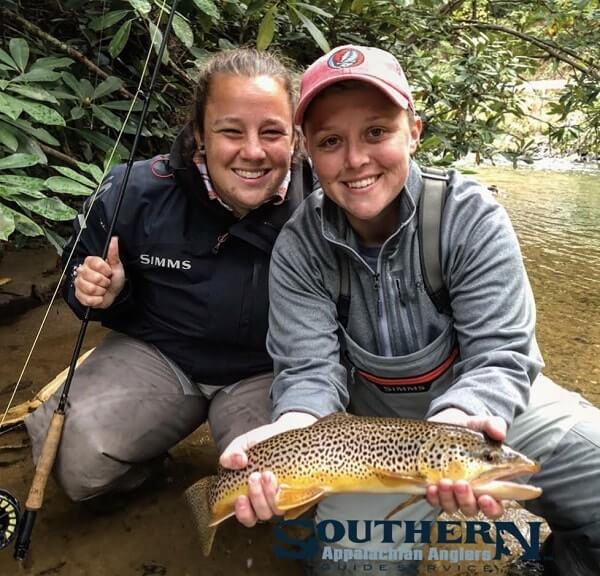
Wild brown caught with Guide Ethan from Southern Appalachian Anglers
How to Set Up a Drop Shot Nymphing System
Author: Ethan Hollifield
It’s hard to argue that nymphing is an effective way to target trout throughout the year, and through varying types of water conditions. Nymphing techniques have multiple branches of skills to be mastered that all have their place on their water, but one thing that can make or break a nymph system is your leader set up. In this article I’ll discuss my favorite leader set up for a technique called drop shot nymphing, which can be utilized on virtually all water types here in western North Carolina where trout are present.
A leader in fly fishing is the tapered mono/ fluro line that connects the fly line to your flies. How leaders are made, or built, will determine their overall performance in the water; most specifically the sink rate/ turn over of heavily weighted streamers and nymph rigs.
The Drop Shot Set Up
One of my favorite systems that I run for all water conditions is drop shot nymphing. Drop shot nymphing was made famous by Kelly Galloup, and the system I use is based off of his with some slight modifications. My leader formula for drop shot nymphing is as follows: 9-15 feet of Maxima Hard Mono (depending on water depth) starting with 30lb, 25lb, 20lb, 15lb, then 10lb test segments down to a steelhead grade tippet ring which I attach using a uni-knot. From this tippet ring I’ll attach generally a 1’ – 2’ of 5x tippet (size and mono vs fluro are based on water conditions). At the end of the tippet is my point fly, which describes the heaviest fly you’ll have. In the middle of the tippet segment I’ll tie a surgeon’s knot which acts as a stopper for a dropper tag. Now, all I use for a dropper tag is a 4” section of 5x tippet to my dropper fly (the fly of lesser weight in the system). The other end of the the dropper tag is tied off with a perfection loop. The fly is passed through the loop above the surgeon’s knot in my section of 5x attached to the point fly and pulled tight. Having this dropper tag allows for the top fly to move more freely in the water and keeps it at a true 90-degree angle away from the main tippet. Lastly, if conditions call for added weight: I’ll attach another segment of tippet off of the bend of the hook to my point fly (around 6-8”). At the tag end, I’ll tie off another surgeon’s knot for a stopper and add a piece(s) of split shot depending on water speed and depth. Place a strike indicator above the tippet ring, and you’re ready to fish.
How To Fish It
The beauty about this system is how it allows your nymphs to make close contact with the bottom much faster, and that comes with where weight is placed on the leader. Having the majority of the weight at the very end of the leader system allows for the nymphs to mimic a pendulum in the water: falling with the weight first, which helps get down deeper in the water column than other nymph systems. You can also utilize this technique with czech nymphing, and with both techniques since the weight is located below the flies: 90% of what you’ll lose in a hang up is just the split shot at the point. This system also works well substituting the split shot for a tungsten-beaded nymph.
Drop-shot nymphing offers the fly angler a more natural presentation that can produce fish in conditions year round. With cold weather arriving here in the mountains and nymphing on everyone’s mind; there’s no better time to try it.
